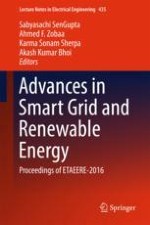2018 | OriginalPaper | Chapter
Renewable Energy Capacity Estimation for Indian Energy Sector Using Energy Demand Forecasting Through Fuzzy Time Series
Authors : Shibabrata Choudhury, Aswini Kumar Patra, Adikanda Parida, Saibal Chatterjee
Published in: Advances in Smart Grid and Renewable Energy
Publisher: Springer Singapore
Activate our intelligent search to find suitable subject content or patents.
Select sections of text to find matching patents with Artificial Intelligence. powered by
Select sections of text to find additional relevant content using AI-assisted search. powered by
